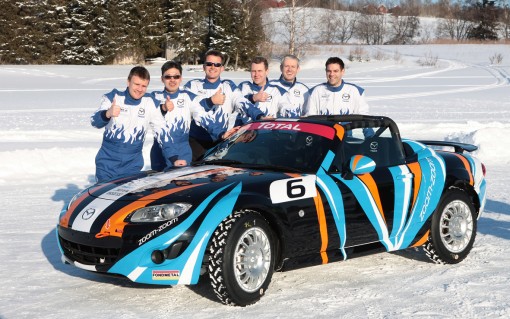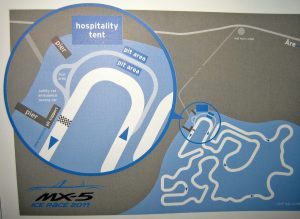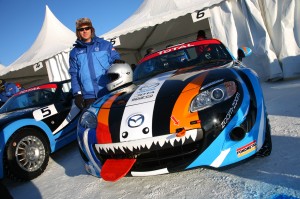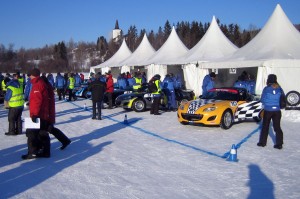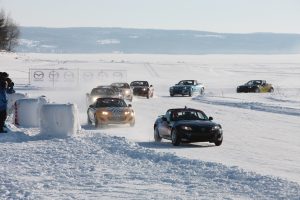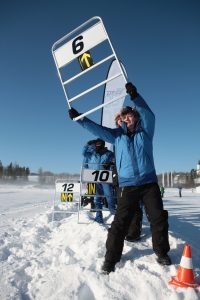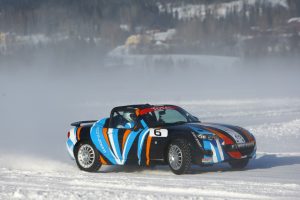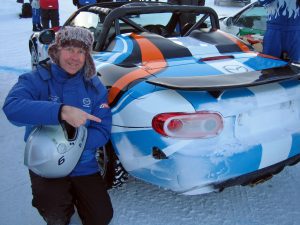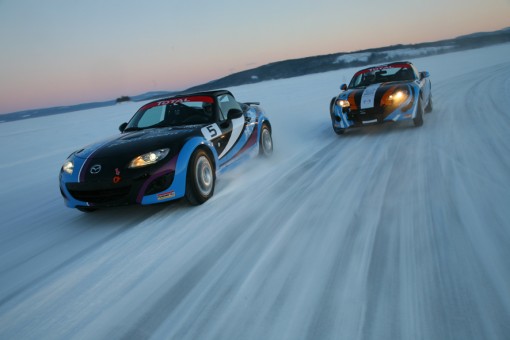Mazda MX5s turn up heat in -30 degree ice race
Racing open top MX-5s on a frozen lake in -30 degree temperatures. DAVID HOOPER drives for Mazda’s Team UK in Sweden against teams from across Europe.
THE world’s favourite sports car is celebrating its 21st birthday this year – and Mazda Europe chose Sweden as the venue for a quite unique party!
With temperatures dipping below -30 in northern Sweden’s Jamtland province, not far from the Arctic Circle, Lake Kallsjon played host to a thrilling event which saw 120 drivers from 26 countries race open-topped Mazda MX-5s on a frozen lake in a four-hour endurance race.
The brilliant two-seater holds a Guinness world record for being the best-selling open top two-seater sports car, and on this frosty stage the MX-5 proved beyond question that it’s tremendous fun to drive, whatever the weather.
Organised by Mazda Europe to celebrate the iconic car’s milestone and over 900,000 cars built since 1989, the 2011 Mazda MX-5 Ice Race was staged at the Kall Auto Lodge, a driving experience centre, located in the shadow of the Areskutan mountain.
Situated 386m above sea level, it is 35-40km wide, and worryingly, 134m deep, but we were assured that the ice is 40-60cm deep at this time of year.
We flew from Stockholm to Ostersund, and were based in the ski resort of Are.
Carved into the surface of the frozen lake, the track itself was 4.5km long with hardly a straight in sight, and the art of getting a quick lap depended on the driver’s ability to drift the car around the track, a driving style more akin to rallying than circuit racing.
The MX-5s were prepared for the event by Engstler Motorsport, owned by former World Touring Car driver Franz Engstler. The MX-5s were stripped of their hoods to accommodate roll cages and fitted with racing harnesses and other safety equipment, but most importantly, rally-spec ice-racing tyres, with huge chunky treads embedded with metal studs.
The two-day event started with two practice sessions on the first day. Drifting a car sideways through corners, and switching from left to right bends by adjusting the throttle pedal and steering angle was a new skill for most of the drivers – a fact demonstrated by the tally of 60 cars which were recovered from snow drifts bordering the track on the first day alone, by means of a rope attached to four-wheel-drive Mazda pick-ups which were quickly on the scene, but as I soon discovered, getting yourself beached cost around five minutes’ driving time, which would equate to a lap on race day.
With six drivers to a car, and every driver having to drive for a minimum of 10 minutes and a maximum of 30 minutes, the race could be won or lost in the pits, so we practised our driver changes, getting the time down to under 30 seconds for a slick driver change.
Grid positions for the race were decided by the team’s fastest laps. Team UK had entered two cars and qualified in fourth and 16th positions.
Race day dawned with clear blue skies and -30 degree temperatures on the lake, which warmed to -24 on the car’s temperature gauge. The MX-5s were lined up on the grid and the race got underway behind the safety car for the first lap, before the racing proper started.
The still conditions meant the snow’s spray hung in the air over the track, creating a mist which was difficult for all but the lead drivers to see through, so there were the inevitable mishaps.
I was reunited with one of the cars I had raced at Snetterton last summer – the same car that put up an impressive display in the Britcar 24-hour race at Silverstone in September. My teammates in Car number 6 included journalists from What Car? Auto Car and Banzai magazines, Mazda’s Global chief designer Maeda-san, who races MX-5s in Japan, earning himself the nickname Speedy, and Mazda UK’s managing director Jeremy Thomson.
We put our most experienced driver in the car to start the race, a ploy which worked well, with him quickly moving up to third place, and after the first hour, our car was top of the leader board as I prepared for my first stint behind the wheel. No pressure then!
Knowing that an “off” would cost us five minutes and therefore a lap, I was determined to keep the car on the track, even if that meant a slightly slower lap time, but after my stint, I handed over to the next driver, relieved that I had done a good job for the team and kept it on the track. We were still top of the leaderboard, but it was nip and tuck with the Australians, who were invited as special guests for the event. They had strapped a kangaroo to the top of their roll cage, and turned up to the drivers’ briefing wearing brightly coloured swimming trunks. Brought up with rear-wheel-drive cars, and with some former rally drivers in their team, their lap times were impressive and were clearly going to give us a run for our money.
The other hot favourites, the Russians, had a bad start, with their best driver spinning out on the opening laps and dropping down to 18th place, but again with several experienced rally drivers in their team, they were to stage an impressive fightback.
The race was in two parts, and by the end of the first session, we had slipped to 5th on the leaderboard after one of our drivers went off and had to be rescued from a snow drift. Team UK’s second car was in 18th place.
The second session started with another rolling start. Our car began the afternoon from fifth place on the grid, but another “off” cost us more time and another lap. As I took my turn in the car, we had to go for it if we were to claim our place on the podium.
I had a thrilling battle with two cars which lasted for most of my second lap, eventually passing both, but was soon caught by another car on my third lap and battle was rejoined. He wasn’t coming past without a fight, but a couple of blue flags in quick succession meant I had to get out of his way, which I would have done on the wider part of the circuit just a couple of corners away, but before we got there . . . Bang! I was hit from behind, and both cars spun off. Fortunately our rear wheels stayed on the track and both cars quickly rejoined under our own steam, although my MX-5 had a big hole in its back bumper!
Our last driver had a long stint in the hope of making up some more places if the other cars got stuck in the snow, but despite our best efforts, we finished in eighth place, just two laps down.
A thrilling finish was in store though, with the Russians, the Australians and the Belgians pushing each other hard until the very last lap, with the Russian’s just pipping the Aussies to the top step of the podium and the champagne. After four hours’ racing, there was only 1min 10secs between the two teams, with the Belgians, who included ex-Formula One test driver Jeffrey Van Hooydonk in their line-up, a further 1min 40secs behind. The second UK car finished in 15th place.
Only four cars finished on the same lap, and despite the very harsh conditions, all 20 finished the race with no mechanical issues, which is a real testament to their durability and reliability in such extreme conditions. During the two-day event, they were driven for 157 hours in arctic conditions, covering 550km per car – around 11,000km in total.
As Mazda’s European president and CEO, Jeff Guyton said, there were no losers, everyone was a winner, especially the MX-5, which proved once again how much fun can be had in a great little car, whatever the weather.
Happy 21st birthday to the MX-5 – and may it have many more – although I doubt few will be as memorable as this one was for those who took part.

